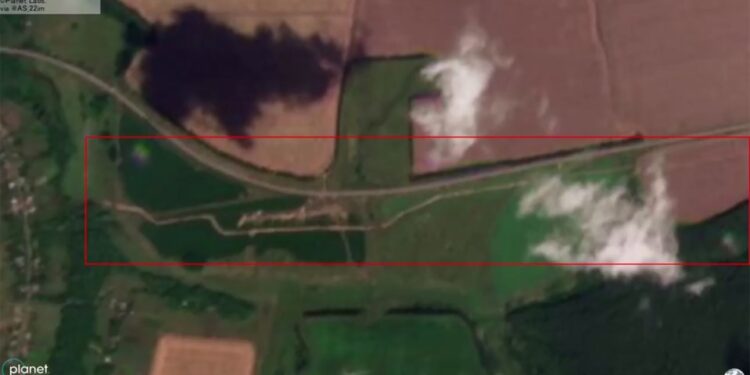SATELLITE pictures have revealed how panicked Putin could be turning a power plant into a nuclear fortress amid fears that Ukraine will seek to grab it.
Strict new controls have been imposed on entry into Kurchatov town as Zelensky’s troops seized 100 towns during their brave advance into Kursk.
Kurchatov is the location of Kursk Nuclear Power Plant, around 25 miles from the fighting.
There are fears Ukraine is already seeking to penetrate the town with advance sabotage teams.
Kursk Governor Alexei Smirnov warned: “Despite the fact that the security of the Kursk Nuclear Power Plant is maximised, the Ukrainian Armed Forces are not abandoning their attempts to penetrate the town.
“The counter-terrorism regime’s operational headquarters has decided to limit entry to Kurchatov in the near future.”
Read more on Vladimir Putin
Satellite pictures appear to show trenches and barricades being built around the town.
Russian despot Vladimir Putin earlier claimed Ukrainian troops had attempted to attack the plant, though there was no hard evidence of this.
Ukraine has denied any plans to attack the plant.
Rafael Grossi, head of the International Atomic Energy Agency (IAEA), stated on a recent visit that “there is a risk of a nuclear incident,” stressing proximity to ongoing fighting at the plant was “extremely serious.”
Grossi was shown debris of drones which Moscow says were sent by Ukraine.
“I was informed about the impact of drones,” he said.
“I was shown some of the remnants of those, signs of the impact they had.”
Some Russian analysts believed the aim of Ukraine’s incursion into the Kursk region was to grab or disable the power station.
It comes as Russia deployed some 30,000 troops to the new frontline in Kursk as Putin desperately tries to fend off Ukraine’s forces.
Mad Vlad also appears to have called in reinforcements from ally Belarus as their tanks branded with telltale “B” signs mass on the Ukrainian border in an echo of the “Z” used by Russia.
Ukraine is holding strong onto 100 towns and settlements inside Kursk after first invading Russia on August 6, more than three weeks ago.
Zelensky’s forces have attacked border checkpoints in the Belgorod region, attempting to push into another one of Putin’s cities.
Ukraine has also used F-16 fighter jets for the first time in the war so far.
Commanders scrambled F-16 Fighting Falcons to intercept Russian rockets and drones during two days of devastating bombardments.
The jets soared into battle as Moscow unleashed more than 300 missiles and drones, including Kinzhal hypersonic missiles, Iranian Shahed one-way attack drones and submarine launched Kalibr cruise missiles.
Why has the Ukrainian invasion of Russia been so successful?

By Georgie English, Foreign News Reporter
A DARING Ukrainian military push into Russia’s Kursk region has become the largest attack on the country since World War Two.
Kyiv’s forces have seized scores of villages, taken hundreds of prisoners and forced the evacuation of tens of thousands of civilians.
After more than a week of fighting, Russian troops are still struggling to drive out the invaders.
Why has Russian military been caught so unprepared?
A long undefended border
Russia’s regions of Kursk, Bryansk and Belgorod share a 720-mile border with Ukraine – including a 152-mile section in the Kursk region.
And it only had symbolic protection before Moscow invaded Ukraine in 2022.
It’s been reinforced since then with checkpoints on key roads and field fortifications in places – but not enough to repel a Ukrainian assault.
The most capable Russian units are fighting in eastern Ukraine, leaving the border vulnerable to attack.
Element of surprise
Ukrainian troops participating in the incursion were reportedly only told about their mission a day before it began.
The secrecy contrasted with last year’s counteroffensive – when Ukraine openly declared its goal of cutting the land corridor to annexed Crimea.
Ukraine ended up failing as troops trudged through Russian minefields and were pummelled by artillery and drones.
But in Kursk, Ukrainian troops didn’t face any of these obstacles.
Battle-hardened units easily overwhelmed Russian border guards and small infantry units made up of inexperienced conscripts.
The Ukrainians drove deep into the region in several directions – facing little resistance and sowing chaos and panic.
Russia’s slow response
The Russian military command initially relied on warplanes and choppers to try to stop the onslaught.
At least one Russian helicopter gunship was shot down and another was damaged.
Moscow began pulling in reinforcements, managing to slow Ukraine’s advances – but failed to completely block troops.













